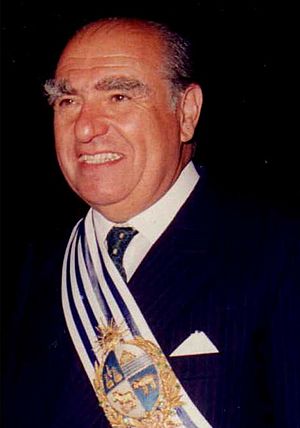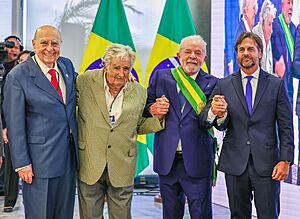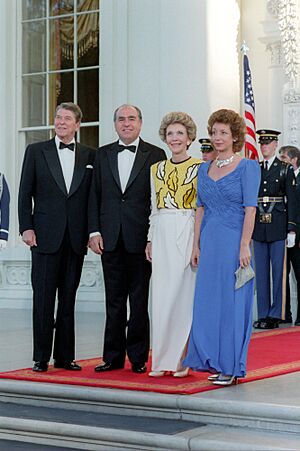Julio María Sanguinetti facts for kids
Quick facts for kids
Julio María Sanguinetti
|
|
|---|---|

Sanguinetti in 1995
|
|
| 35th and 37th President of Uruguay | |
| In office 1 March 1995 – 1 March 2000 |
|
| Vice President |
|
| Preceded by | Luis Alberto Lacalle |
| Succeeded by | Jorge Batlle |
| In office 1 March 1985 – 1 March 1990 |
|
| Vice President | Enrique Tarigo |
| Preceded by | Rafael Addiego Bruno (acting) |
| Succeeded by | Luis Alberto Lacalle |
| Minister of Education and Culture | |
| In office 1 March 1972 – 27 October 1972 |
|
| President | Juan María Bordaberry |
| Preceded by | Ángel Rath |
| Succeeded by | José María Robaina Ansó |
| Minister of Industry and Commerce | |
| In office 15 September 1969 – 2 April 1971 |
|
| President | Jorge Pacheco Areco |
| Preceded by | Venancio Flores |
| Succeeded by | Juan Pedro Amestoy |
| Personal details | |
| Born | 6 January 1936 Montevideo, Uruguay |
| Political party | Colorado Party |
| Spouse | Marta Canessa |
| Children | 2 |
| Residences | Punta Carretas, Montevideo |
| Alma mater | University of the Republic |
| Occupation | Politician |
| Profession | Journalist, Lawyer |
| Signature |  |
Julio María Sanguinetti Coirolo (born 6 January 1936) is a Uruguayan former lawyer, journalist, and politician. He was the President of Uruguay two times: from 1985 to 1990, and again from 1995 to 2000. He was the first president chosen by the people after twelve years when the military was in charge of the country.
Julio Sanguinetti was born in Montevideo, Uruguay. He studied law and became a lawyer in 1961. He also worked as a journalist, writing for newspapers like Acción. He reported on important events, including the Cuban Revolution.
In 1962, Sanguinetti was elected as a representative for Montevideo. He later became a government minister, first for Industry and Commerce in 1969, and then for Education and Culture in 1972. He did not agree with the military taking control of the government in 1973. He worked to bring democracy back to Uruguay.
Sanguinetti helped create an agreement called the Naval Club Pact. This agreement made it possible for Uruguay to return to democracy. In 1984, he was elected president. During his first time as president, he helped people who had been jailed for political reasons. He also made Uruguay part of a group of countries called Mercosur, which helps them trade with each other.
Contents
Early Life and Education
Julio Sanguinetti was born in Montevideo on January 6, 1936. His family had Italian roots. He grew up in a family that had different political ideas.
When he was a teenager, he joined the Colorado Party. He went to Elbio Fernández School. In 1955, he started studying at the University of the Republic. He finished his law degree in 1961.
Starting in Politics
In 1963, when he was 27, Sanguinetti became a member of the Chamber of Representatives for Montevideo Department. In 1964, he was part of Uruguay's group that helped start the United Nations Conference on Trade and Development (UNCTAD) in Geneva.
In 1966, Sanguinetti helped write the new Constitution for Uruguay. From 1967, he advised President Jorge Pacheco Areco on matters related to the Organization of American States. In 1969, he became the Minister for Industry and Commerce. He held this job until 1971. Then, he led Uruguay's trade group to the USSR. He also became a deputy editor for the newspaper Acción.
In March 1972, President Juan María Bordaberry asked him to be the Minister for Education and Culture. In the same year, Sanguinetti helped create the National Commission for the Historical, Artistic and Cultural Heritage of the Nation.
Bringing Back Democracy
When the military took control of the government in June 1973, Sanguinetti lost his government jobs. He also lost his job at the Acción newspaper, which was shut down. In 1976, he was not allowed to take part in any political activities.
During these years, Sanguinetti worked as a journalist. He wrote for El Día Newspaper and Visión Newspaper, sharing his views against the military government. He also started a weekly paper called Correo de los Viernes in 1981. He helped promote cultural and sports activities. He was the president of a UNESCO center that promoted books in South America. He was also the Vice-President of the popular Peñarol Football Club.
After the people voted against a new constitution in 1980, Sanguinetti was allowed to be involved in politics again in 1981. He led his party's talks with the army to bring back democracy peacefully. These talks led to the Naval Club Pact in 1984. In 1983, he became the Secretary General of his party. In August 1984, he was chosen as the main candidate for president. This led to the end of 12 years of military rule.
His First Time as President (1985–1990)
On November 25, 1984, elections were held. Sanguinetti won with 31.2% of the votes. On March 1, 1985, he became president for a five-year term. Many foreign leaders came to the ceremony, showing their support for Uruguay's new democracy.
Sanguinetti was seen as a modern politician who was careful with money matters. He helped his party, which had many different ideas. He immediately allowed political parties and leaders who had been banned to return. He also signed a law that pardoned political prisoners.
In foreign relations, Sanguinetti restarted connections with Spain and other countries. In 1987, he signed an agreement with Argentina's president, Raúl Alfonsín. This agreement helped boost trade and cooperation in the region. This work, which later included Brazil and Paraguay, led to the creation of the Southern Common Market (MERCOSUR) in 1991.
One of his main goals was to reduce Uruguay's large foreign debt. He also worked with other countries in groups that aimed to prevent conflicts in Central America. Uruguay's economy improved during his first term. Production grew, inflation went down, and more goods were exported.
Towards the end of his first presidency, Uruguay's foreign debt was still high. Inflation also increased. On March 1, 1990, Sanguinetti handed over the presidency to Luis Alberto Lacalle. After his presidency, Sanguinetti continued his work in journalism and academics. He also remained active in his party.
His Second Time as President (1995–2000)
Sanguinetti ran for president again in the 1994 elections on November 27. He won with 24.7% of the votes. Even though another candidate, Tabaré Vázquez, received more individual votes, Sanguinetti's party, the Colorados, received the most votes overall. This was due to an old election rule called the Ley de Lemas. On March 1, 1995, Sanguinetti became president for the third time in the country's history.
Sanguinetti formed a government with other parties. This helped him pass laws and reforms, including changes to the Social Security Law and the Constitution. The constitutional reform, which was approved by voters in 1997, changed the election system. It made it so each party could only have one presidential candidate. If no one won a majority in the first round, the top two candidates would go to a second round.
His government's economic policies helped reduce a recession and led to strong growth. Inflation also decreased. More jobs were created, and salaries improved. However, an economic crisis in Brazil in 1998-1999 affected Uruguay. Brazil bought fewer products from Uruguay, which hurt Uruguay's exports. Sanguinetti hosted several MERCOSUR meetings during this time.
On March 1, 2000, his second term as president ended. He handed over the presidency to his party colleague, Jorge Batlle.
After Being President (2000–Present)

Sanguinetti has always been active in journalism and culture. Between his two presidencies (1990-1995), he wrote for Spanish news companies. He also directed seminars and gave lectures in Spain.
Since 1996, he has promoted a group called the Montevideo Circle. This group brings together important political and intellectual figures from around the world. He is also the President of the PAX Institute, which is a foundation for international action. He is a member of other groups that offer advice on global issues, like the InterAcción Council and the Council of Presidents and Prime Ministers of the Carter Center. He is also part of the Inter-American Dialogue, a think tank in Washington D.C.
Sanguinetti supported the law that allowed same-sex marriage in Uruguay.
In 2019, Sanguinetti ran for president again in the primary elections. He came in second. After being elected as a senator in October 2019, Sanguinetti said he wanted to help the government from Parliament. He later resigned from his senator seat in October 2020 to focus fully on his party.
His Books
Sanguinetti has received special honorary degrees from universities in different countries. He has also written many books. Some of his book titles include:
- The Scope and Application of the New Uruguayan Constitution (1967)
- The Nation, Nationalism and other '-isms' (1978)
- Fear and Impatience (1991)
- The Year 501 (1992)
- A World without Marx (1993)
- Meditations of the Millennium (1994)
- Doctor Figari (2002)
- Agony of a Democracy (2008)
- The Reconquest, Process of Uruguay's Democratic Restoration (1980-1990) (2012)
- Portraits from Memory (2015)
- The Reporter and History (2017)
Family Life
Julio Sanguinetti is married to Marta Canessa, who is a historian and journalist. They have two children, Julio Luis and Emma, both of whom are lawyers.
Awards and Honors
Foreign Honors
 Argentina:
Argentina:
 Brazil:
Brazil:
 Grand Collar of the National Order of the Southern Cross
Grand Collar of the National Order of the Southern Cross
 Chile:
Chile:
 Colombia:
Colombia:
 El Salvador:
El Salvador:
 France:
France:
 Grand Cross of the National Order of Legion of Honour
Grand Cross of the National Order of Legion of Honour
 Guatemala:
Guatemala:
 Italy:
Italy:
 Knight Grand Cross with Collar of the Order of Merit of the Italian Republic
Knight Grand Cross with Collar of the Order of Merit of the Italian Republic
 Malaysia:
Malaysia:
 Mexico:
Mexico:
 Collar of the Order of the Aztec Eagle
Collar of the Order of the Aztec Eagle
 Panama:
Panama:
 Paraguay:
Paraguay:
 Peru:
Peru:
 Spain:
Spain:
 Knight of the Collar of the Order of Isabella the Catholic
Knight of the Collar of the Order of Isabella the Catholic
 Venezuela:
Venezuela:
Awards
In 2007, Sanguinetti received a special award for his lifetime achievements from the Cristóbal Gabarrón Foundation in Spain.
See also
 In Spanish: Julio María Sanguinetti para niños
In Spanish: Julio María Sanguinetti para niños
- Politics of Uruguay
- List of political families#Uruguay


